
Animals that start with Y include mammals such as the yak, yapok, yellow-winged bat and yellow mongoose; birds such as the yellowhammer and yellow-eyed penguin; reptiles such as the yacare caiman; and invertebrates such as the yabby and yellowjackets.
On this page is a list including these and many other interesting animals beginning with Y, together with pictures and facts on each species.
Below each animal you’ll find links that you can follow for further information, pictures and videos.
Included in this list are individual species (e.g., the Yacare caiman) and groups of animals (e.g., yellowjackets) whose names begin with Y.
The scientific name and conservation status are provided for each of the individual species.
Index
Scroll down to see pictures and facts on all of the animals, or use the index below to go directly to a particular animal.
List Of Animals Beginning With Y

- Yabby (Common)
- Yacare Caiman
- Yak
- Yapok
- Yellow Ground Squirrel
- Yellow Mongoose
- Yellow-Backed Duiker
- Yellow-Bellied Sapsucker
- Yellow-Bellied Marmot
- Yellow-Bellied Weasel
- Yellow-Eyed Penguin
- Yellow-Footed Antechinus
- Yellow-Footed Rock Wallaby
- Yellowhammer
- Yellowjacket
- Yellow-Necked Field Mouse
- Yellow-Nosed Cotton Rat
- Yellow-Pine Chipmunk
- Yellow-Throated Marten
- Yellow-Winged Bat
- Yorkshire Terrier
- Yucatan Squirrel
- Yuma Myotis
You can find animals beginning with other letters by clicking on the squares below…
Yabby (Common)
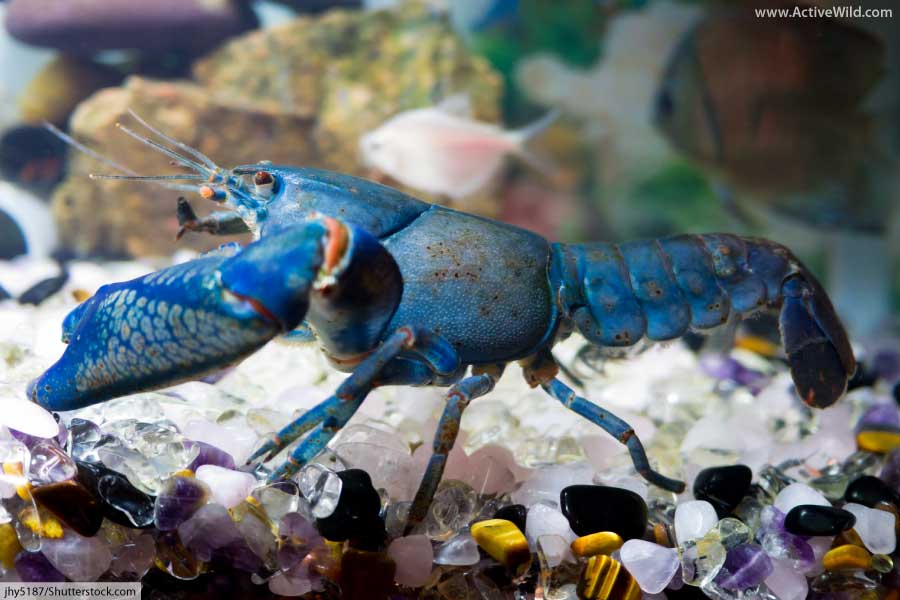
- Scientific name: Cherax destructor
- Type of animal: Crustacean
- Family: Parastacidae
- Where found: Australia
- Conservation status: Vulnerable
The common yabby is an Australian freshwater crayfish of genus Cherax. The species is also known as the “blue yabby” due to its bright blue color. (The name “yabby” is also used for other crayfish species in Australia.)
Although most common in southeastern Australia, the common yabby is also present in many other parts of the country.
The common yabby has been introduced by humans to Western Australia, where today it is considered a pest, as its presence is detrimental to other crayfish species, including the gilgie (Cherax quinquecarinatus).
Yabbies are found in swamps, streams, reservoirs and a variety of other freshwater habitats. Catching yabbies is a popular summer activity in Australia.
Discover More with Active Wild
You can see more Australian animals on this page: Australian Animals List with Pictures & Facts
Yacare Caiman
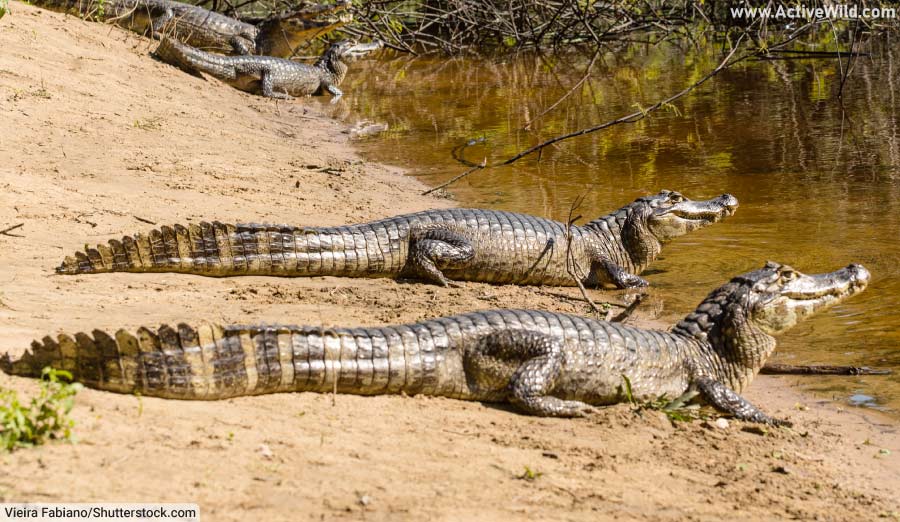
- Scientific name: Caiman yacare
- Type of animal: Reptile
- Family: Caimaninae
- Where found: South America
- Conservation status: Least Concern
The yacare caiman is one of six living caiman species. Caimans are crocodilians in the alligator family, Alligatoridae. Like other crocodilians, they have long bodies, short legs, powerful jaws and tough, scaly skin.
The yacare caiman is found in rivers and wetlands in Argentina, Bolivia, Brazil and Paraguay. It is a mid-sized crocodilian, with large males growing up to 3 m / 9.84 ft. Females are significantly smaller. It is closely related to the spectacled caiman, which is found further north.
Up to 10 million yacare caimans are present in the Pantanal, an area of tropical wetland located mostly in Brazil.
Discover More with Active Wild
Discover more about caimans on this page: Caiman Facts
You can find out more about reptiles on this page: Reptiles – The Ultimate Guide
See more examples of reptiles on this page: Types of Reptiles With Pictures & Facts
Yak
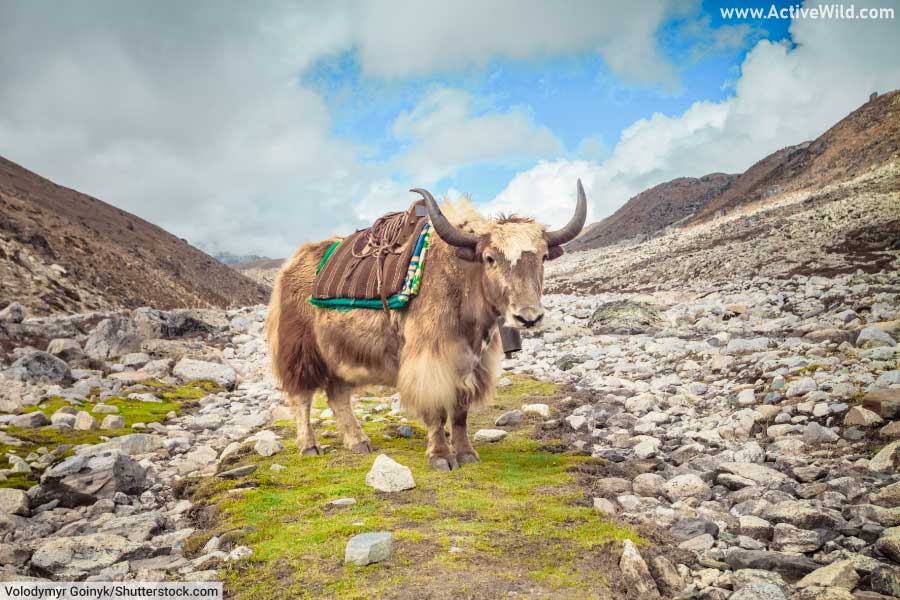
- Scientific name: Bos grunniens
- Type of animal: Mammal
- Family: Bovidae
- Where found: Asia
- Conservation status: Domestic
There are two species of yak: the domestic yak, Bos grunniens, and the wild yak, Bos mutus.
These large, long-haired mammals belong to the family Bovidae, which also contains cattle, buffalo, antelopes and several other hooved animals.
Yaks are found in the Himalayas. Their long, shaggy hair and thick woolly undercoats are adaptations for the cold, mountainous environment.
The domestic yak is descended from the wild yak. It is used for transportation and is also farmed for its milk and meat.
Discover More with Active Wild
You can find out more about the wild yak on this page: Wild Yak Facts
You can see more Asian animals on this page: Asian Animals List with Pictures & Facts
Discover more about horns and horned animals on this page: Animals With Horns Pictures & Facts
Yapok
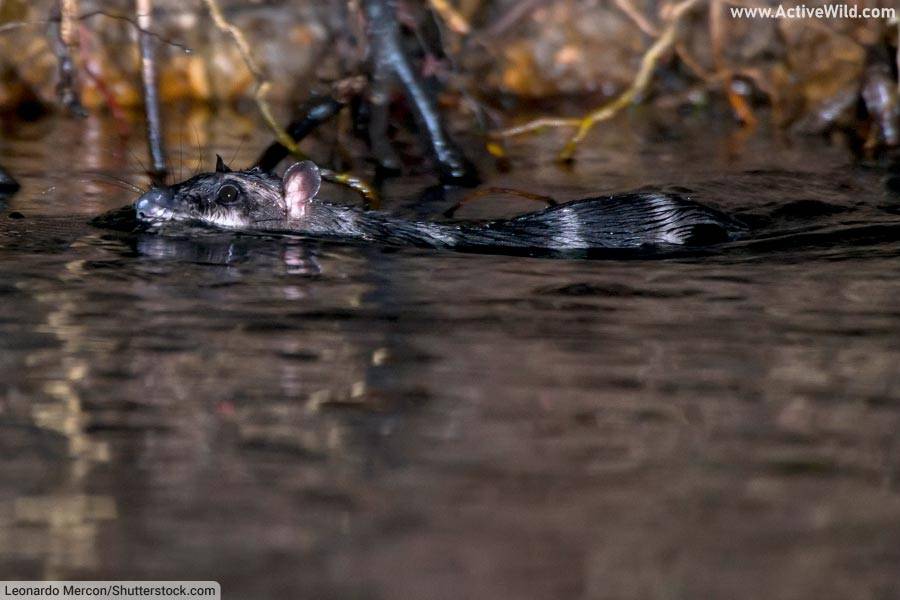
- Scientific name: Chironectes minimus
- Type of animal: Mammal (Marsupial)
- Family: Didelphidae
- Where found: South America, North America
- Conservation status: Least Concern
Also known as the water opossum, the yapok is a semiaquatic marsupial found in forest wetlands from Uruguay to Mexico. Unlike the majority of marsupials, the yapok is found in the Americas rather than Australia.
Marsupials are thought to have originated in North America, before spreading to South America and eventually reaching Australia via Antarctica (which, millions of years ago, was joined to South America).
Carrying infants around in a pouch can be problematic for an aquatic animal. To Solve this problem, the yapok has evolved a watertight pouch to keep its young dry. Other adaptations include a water-repellent coat and webbed hindfeet.
The yapok is a small opossum, with a maximum combined body and tail length of around 27.56 inches / 70 cm. It belongs to the same family, Didelphidae, as the more familiar Virginia opossum.
Discover More with Active Wild
You can find out more about marsupials on this page: List of Marsupials with Pictures & Facts
Discover more about the different types of mammal on this page: Types Of Mammals
Yellow Ground Squirrel
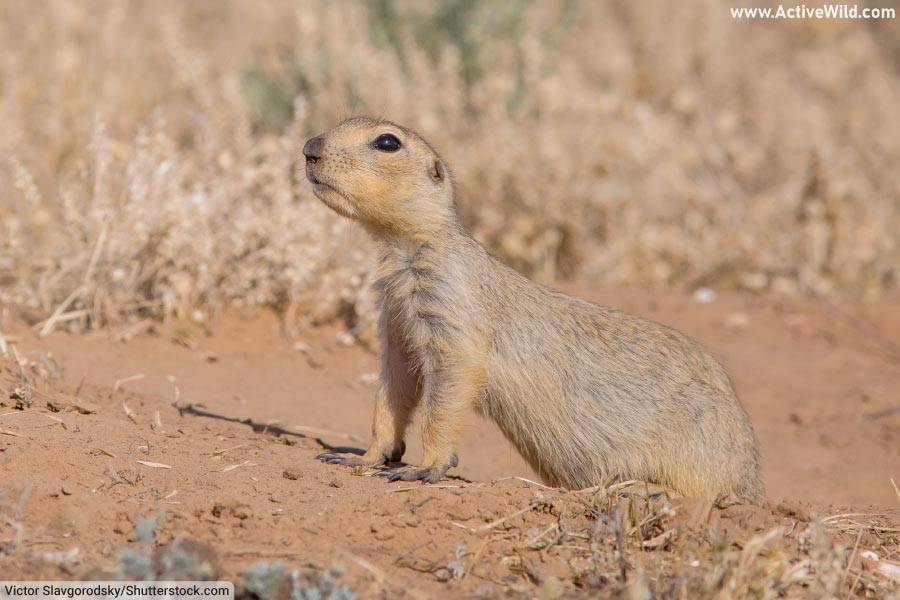
- Scientific name: Spermophilus fulvus
- Type of animal: Mammal
- Family: Sciuridae
- Where found: Asia
- Conservation status: Least Concern
The yellow ground squirrel is a member of the squirrel family Sciuridae. Like other ground squirrels, it is a mid-sized, ground-dwelling rodent.
The squirrel is found on steppes (treeless grasslands and shrublands at high altitudes) in several Asian countries, from Russia south to Afghanistan and Iran. It lives in large colonies and feeds on bulbs, seeds and other plant material.
The yellow ground squirrel has an extended hibernation, emerging in mid-May, and entering hibernation again just three to four months later.
Discover More with Active Wild
You can see more Asian animals on this page: Asian Animals List with Pictures & Facts
Discover more about rodents on this page: Rodents – The Ultimate Guide
Yellow Mongoose
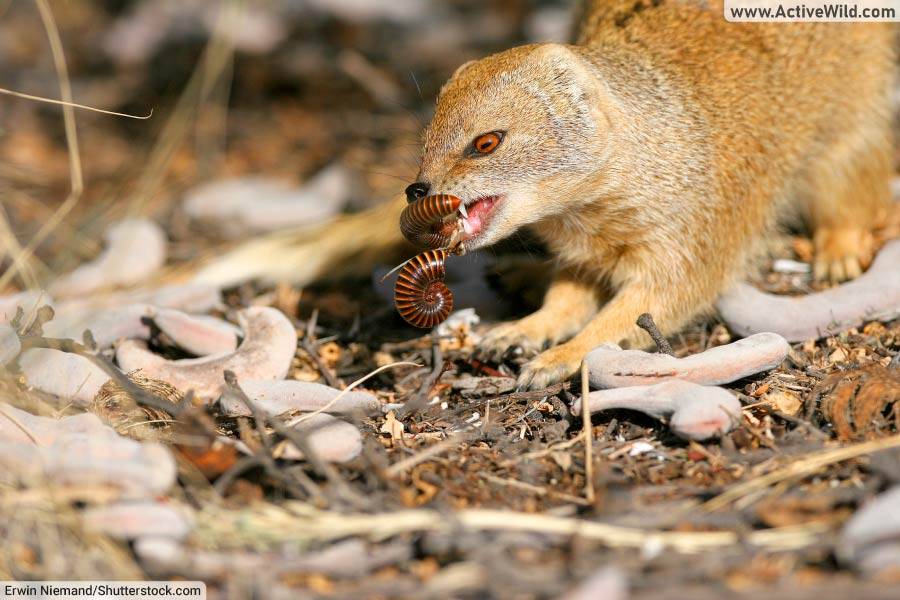
- Scientific name: Cynictis penicillata
- Type of animal: Mammal
- Family: Herpestidae
- Where found: Africa
- Conservation status: Least Concern
The yellow mongoose is one of 23 species in the mongoose family, Herpestidae. It is found in several southern African countries, including Namibia and South Africa.
Like all mongooses, the yellow mongoose has a long body and short legs, giving it a weasel-like appearance. The yellow mongoose has sandy yellow fur.
The species is carnivorous, preying mainly on insects, but also eating eggs, small mammals and reptiles. Yellow mongooses live in family groups of around 20 individuals. The species is a known carrier of rabies.
Discover More with Active Wild
Discover more about the different types of mammal on this page: Types Of Mammals
You can find out more about mammals on this page: Mammals – The Ultimate Guide
Yellow-Backed Duiker
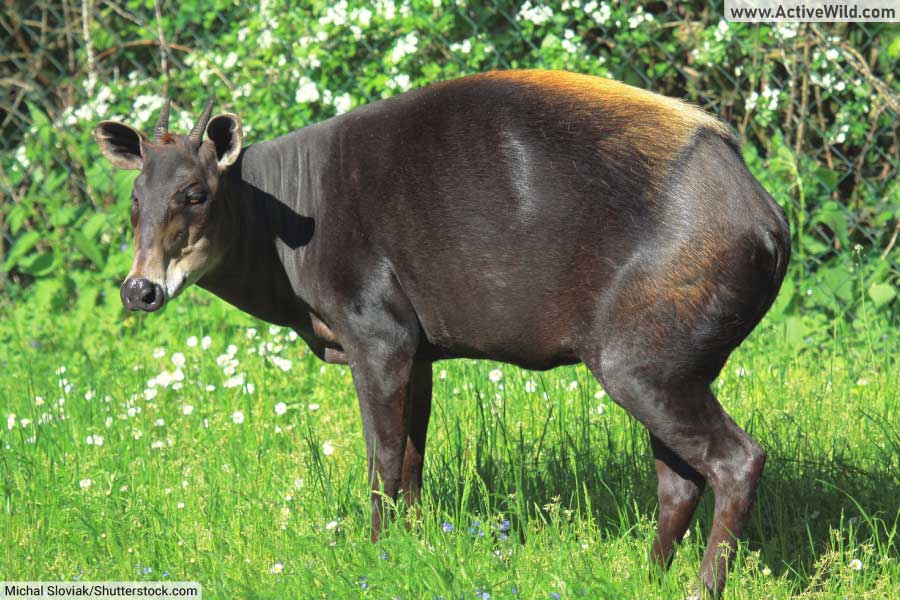
- Scientific name: Cephalophus silvicultor
- Type of animal: Mammal
- Family: Bovidae
- Where found: Africa
- Conservation status: Near Threatened
The yellow-backed duiker is a small antelope found in Central and Western Africa. It is one of 15 antelopes known as duikers, which together make up the genus Cephalophus.
The species is named for the distinctive yellow patch of fur on its back, which is raised when the animal feels threatened.
The yellow-backed duiker, which inhabits forests and woodlands, is threatened by deforestation.
Discover More with Active Wild
You can see more African animals on this page: African Animals List with Pictures & Facts
Discover more about horns and horned animals on this page: Animals With Horns Pictures & Facts
Yellow-Bellied Sapsucker
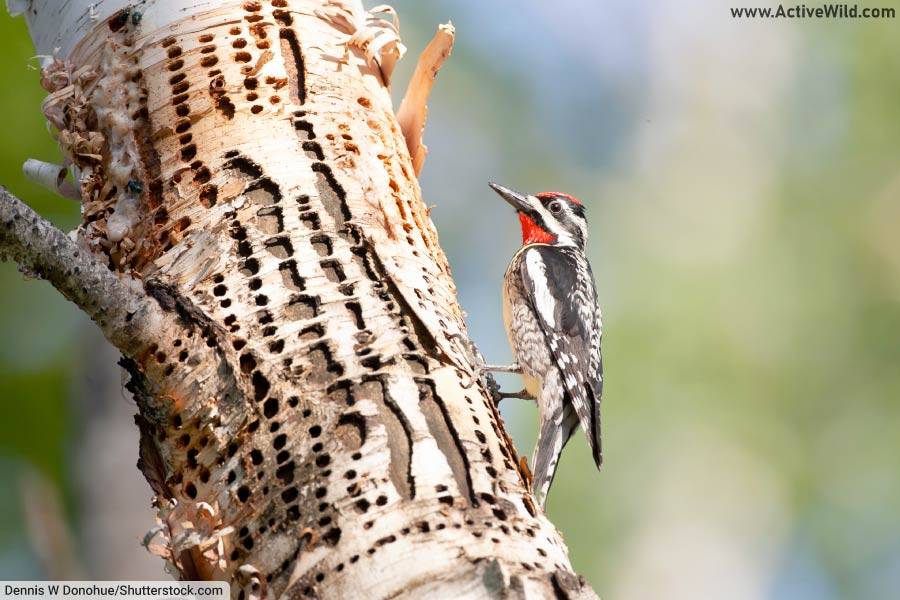
- Scientific name: Sphyrapicus varius
- Type of animal: Bird
- Family: Picidae
- Where found: North America
- Conservation status: Least Concern
A member of the woodpecker family, Picidae, the yellow-bellied sapsucker is found in forests and woodlands in the northeastern United States and Canada.
Like other woodpeckers, the yellow-bellied sapsucker has numerous adaptations for foraging and nesting in trees. It has strong claws and stiffened tail feathers for climbing tree trunks, and a long, strong bill for drilling into the bark.
The yellow-bellied sapsucker makes holes in the bark of trees and feeds on the sap that emerges. It also feeds on insects that are attracted to the sweet substance.
Discover More with Active Wild
Discover more about birds on this page: Birds – The Ultimate Guide
Test your knowledge of North American birds with this free app: North American Bird ID Quiz
Yellow-Bellied Marmot
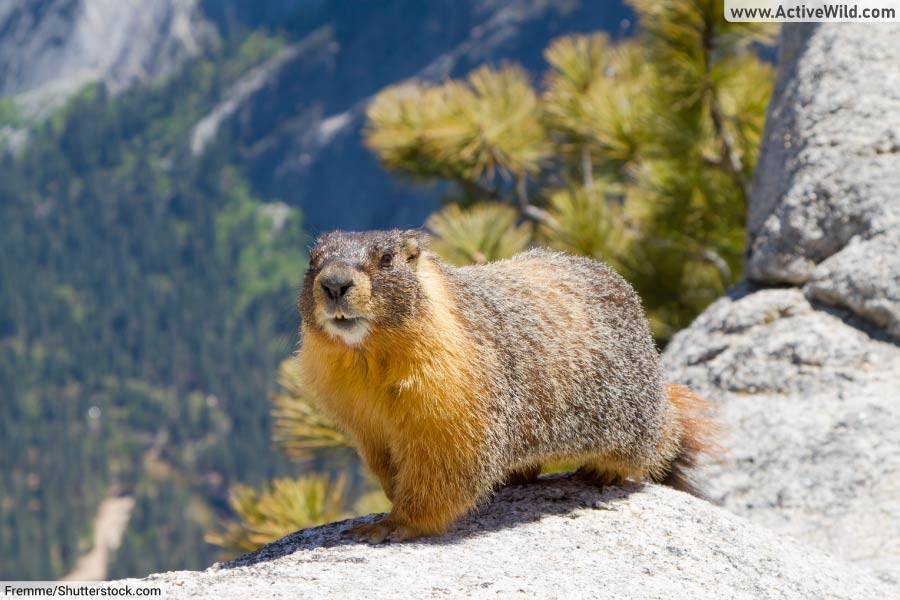
- Scientific name: Marmota flaviventris
- Type of animal: Mammal
- Family: Scuridae
- Where found: North America
- Conservation status: Least Concern
The yellow-bellied marmot is a ground squirrel found in mountainous regions of Canada and the United States. It has a thick grey-brown coat with a patch of yellow hair on its chest, from which it gets its name.
The species lives in colonies consisting of around 20 individuals with a single dominant male. It spends around two-thirds of the year hibernating.
Discover More with Active Wild
You can see more North American animals on this page: North American Animals Pictures & Facts
You can find out more about mammals on this page: Mammals – The Ultimate Guide
Yellow-Bellied Weasel
(No image available)
- Scientific name: Mustela kathiah
- Type of animal: Mammal
- Family: Mustelidae
- Where found: Asia
- Conservation status: Least Concern
The yellow-bellied weasel is a mammal in the weasel family Mustelidae. It is found in several Asian countries, including China, Thailand and Vietnam. It has a long body with short legs, and gets its name from the yellow fur of its undersides.
The yellow-bellied weasel is a solitary hunter that feeds on birds and small mammals. It lives at relatively high altitudes in inaccessible terrain, hence little is known about its lifestyle.
Discover More with Active Wild
You can see more Asian animals on this page: Asian Animals List with Pictures & Facts
You can find out more about mammals on this page: Mammals – The Ultimate Guide
Yellow-Eyed Penguin

- Scientific name: Megadyptes antipodes
- Type of animal: Bird
- Family: Spheniscidae
- Where found: New Zealand
- Conservation status: Endangered
The yellow-eyed penguin is a flightless bird found in New Zealand. It is the fourth-largest of the nineteen living species of penguin. It has a black back and sides, a white chest, pale yellow eyes and a yellow stripe running from eye to eye around the back of its head.
The yellow-eyed penguin was declared endangered in the year 2000. There are under 2,000 breeding pairs and the population is thought to be declining.
The main threat to the species is gillnet fishing. Although the penguin is not deliberately targeted, it is often caught in fishing nets.
Discover More with Active Wild
You can see EVERY species of penguin on this page: Types of Penguins with Pictures
You can find out more about penguins here: Penguin Facts
Discover the penguins of the world’s coldest and least-inhabited continent: Antarctic Penguins
Yellow Footed Antechinus
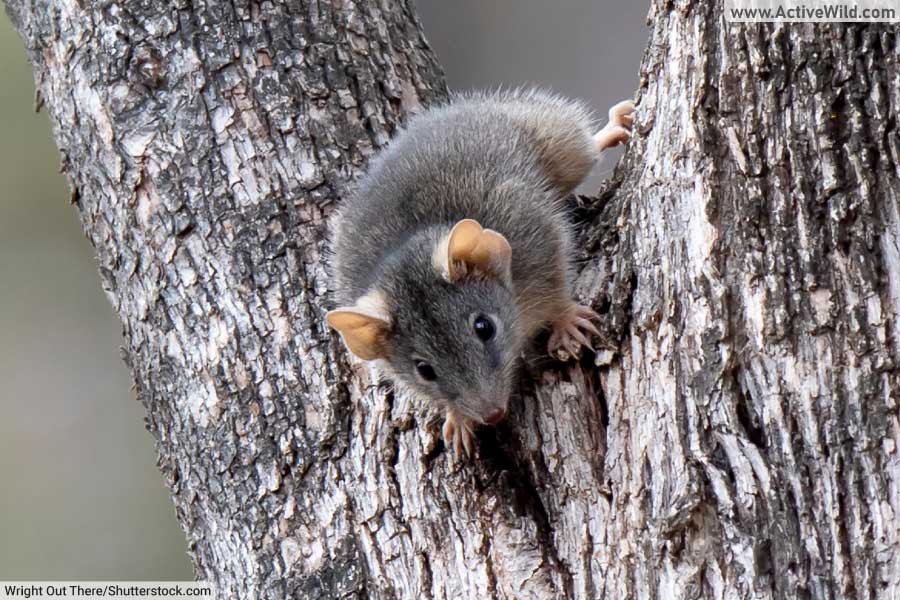
- Scientific name: Antechinus flavipes
- Type of animal: Mammal
- Family: Dasyuridae
- Where found: Australia
- Conservation status: Least Concern
The yellow-footed antechinus is a small, gray, shrew-like marsupial (pouched mammal).
The most widely-distributed member of genus Antechinus, the yellow-footed antechinus has two main populations: one in eastern Australia; one in the southwestern tip of Western Australia.
The species is known for its short lifespan of under a year. Males die shortly after mating, and most females die after weaning their young.
Discover More with Active Wild
You can see more Australian animals on this page: Australian Animals List with Pictures & Facts
Discover more about the different types of mammal on this page: Types Of Mammals
Yellow-Footed Rock Wallaby
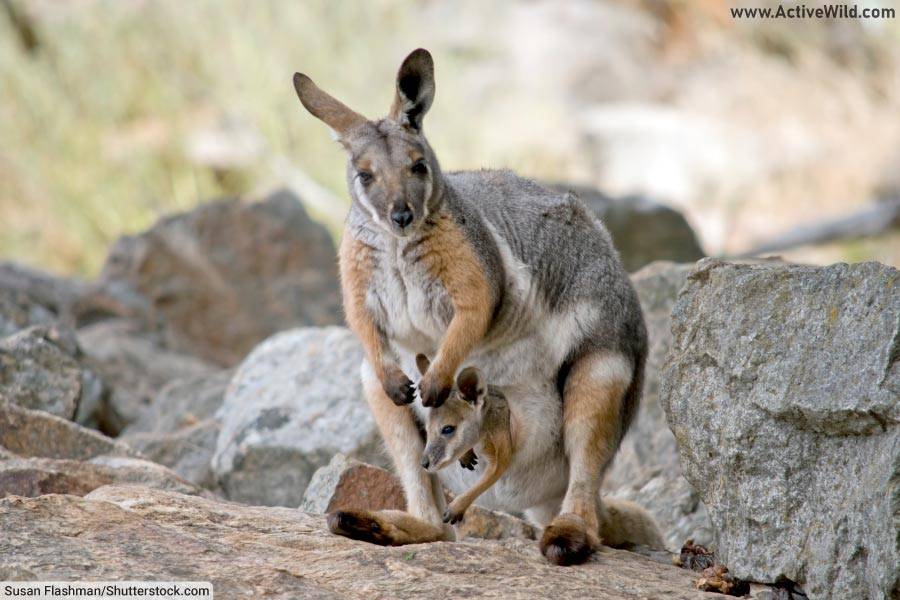
- Scientific name: Petrogale xanthopus
- Type of animal: Mammal
- Family: Macropodidae
- Where found: Australia
- Conservation status: Near Threatened
The yellow-footed rock-wallaby is a macropod (member of the kangaroo family, Macropodidae). It is found in Australia, with separate populations in New South Wales, South Australia and Queensland.
The yellow-footed rock-wallaby is one of 16 species of genus Petrogale, a group whose members are known as rock wallabies. It gets its name from the yellow-brown color of its arms and legs.
Like other rock wallabies, the yellow-footed rock wallaby is agile and a capable climber, able to live in rocky environments.
Once hunted for its skin, today the greatest threat to the yellow rock-wallaby is predation from non-native foxes.
Discover More with Active Wild
You can see more Australian animals on this page: Australian Animals List with Pictures & Facts
Discover more about the different types of mammal on this page: Types Of Mammals
Yellowhammer
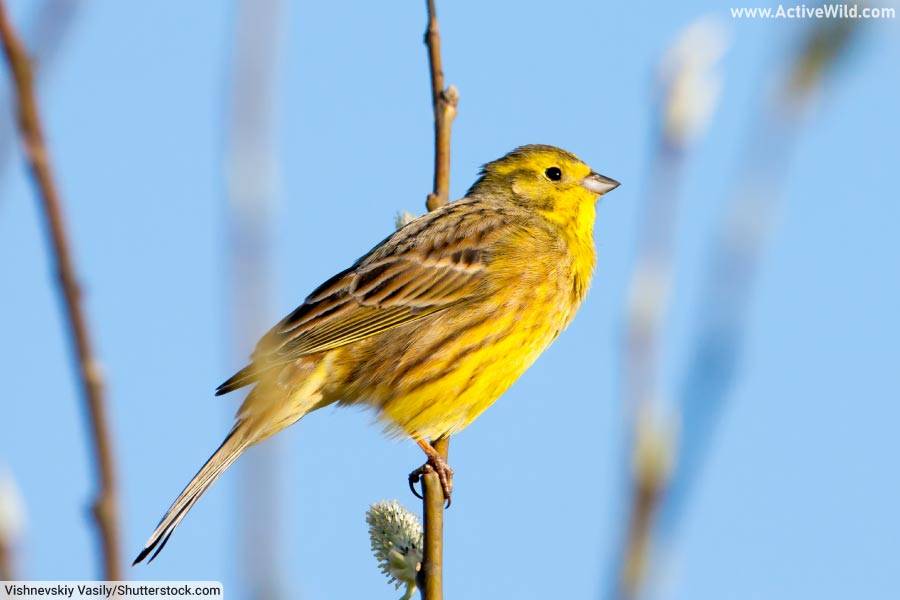
- Scientific name: Emberiza citrinella
- Type of animal: Bird
- Family: Emberizidae
- Where found: Europe, Asia
- Conservation status: Least Concern
The yellowhammer is a passerine (song bird) found across much of Europe and Asia. It belongs to the genus Emberiza, a group of birds known as “buntings”.
With its bright yellow and brown plumage, the male yellowhammer is fairly easy to identify. The female is slightly duller, but still distinctive.
The yellowhammer has a distinctive song, consisting of a series of short high notes, followed by a longer, lower note. The rhythm of the song is likened to the phrase “A little bit of bread and no cheese”. The male can often be seen singing while perched on top of a hedge.
Discover More with Active Wild
You can see more British birds on this page: Common British Birds List with Pictures
Become a bird expert: Birds – The Ultimate Guide
Yellowjacket
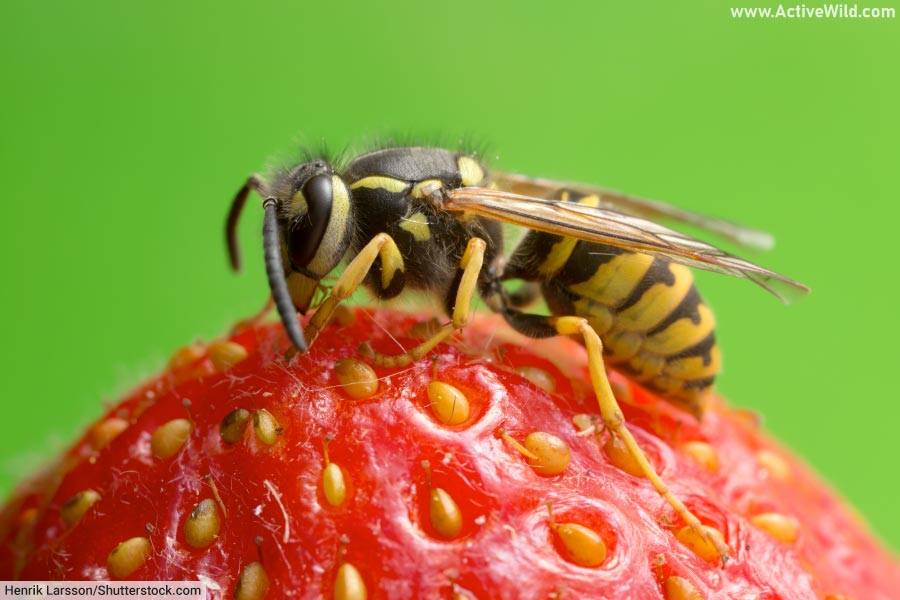
- Type of animal: Insect
Yellowjackets are wasps of genera Vespula and Dolichovespula. Outside of North America, yellowjackets are known simply as “wasps”.
The conspicuous yellow and black ringed abdomen of a yellowjacket warns potential predators that the insect is able to defend itself with a powerful sting. Other, non-stinging, insects (such as hoverflies) mimic this coloration.
Although painful, a sting from a yellowjacket is only potentially dangerous if it causes an allergic reaction in susceptible humans.
Discover More with Active Wild
Discover more about insects: Insects – The Ultimate Guide
Find out why insects are animals: Are Insects Animals?
Yellow-Necked Field Mouse
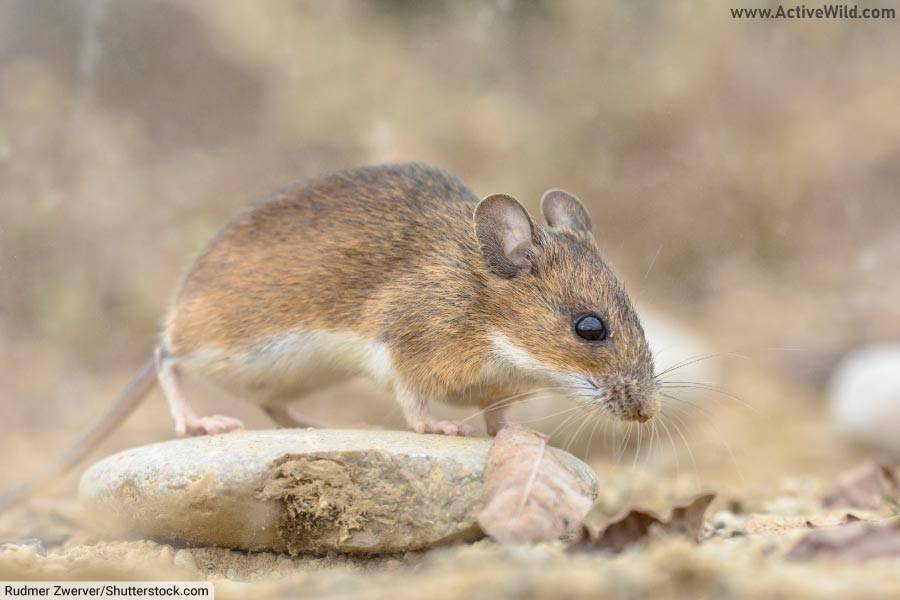
- Scientific name: Apodemus flavicollis
- Type of animal: Mammal
- Family: Muridae
- Where found: Europe
- Conservation status: Least Concern
The yellow-necked mouse is a small mammal belonging to the rat, mice and gerbil family, Muridae. The species is found mainly in Southern Europe, but its range extends northwards into Scandinavia and Great Britain. It has brown fur with a band of yellow around its neck. It is typically found in mountainous woodland.
Discover More with Active Wild
You can find out more about rodents on this page: Rodents – The Ultimate Guide
You can find out more about mammals on this page: Mammals – The Ultimate Guide
Yellow-Nosed Cotton Rat
(No image available)
- Scientific name: Sigmodon ochrognathus
- Type of animal: Mammal
- Family: Cricetidae
- Where found: North America
- Conservation status: Least Concern
The yellow-nosed cotton rat is a member of the family Cricetidae. This rodent family also includes hamsters, voles and lemmings, and is the second biggest mammal family.
(Muridae, which is home to mice, rats and gerbils, is the largest mammalian family.)
The yellow-nosed cotton rat is found in southern United States and Mexico. It has gray fur and an orange nose. It lives in mountainous grasslands and shrublands.
Discover More with Active Wild
You can find out more about rodents on this page: Rodents – The Ultimate Guide
You can find out more about mammals on this page: Mammals – The Ultimate Guide
You can see more North American animals on this page: North American Animals Pictures & Facts
Yellow-Pine Chipmunk
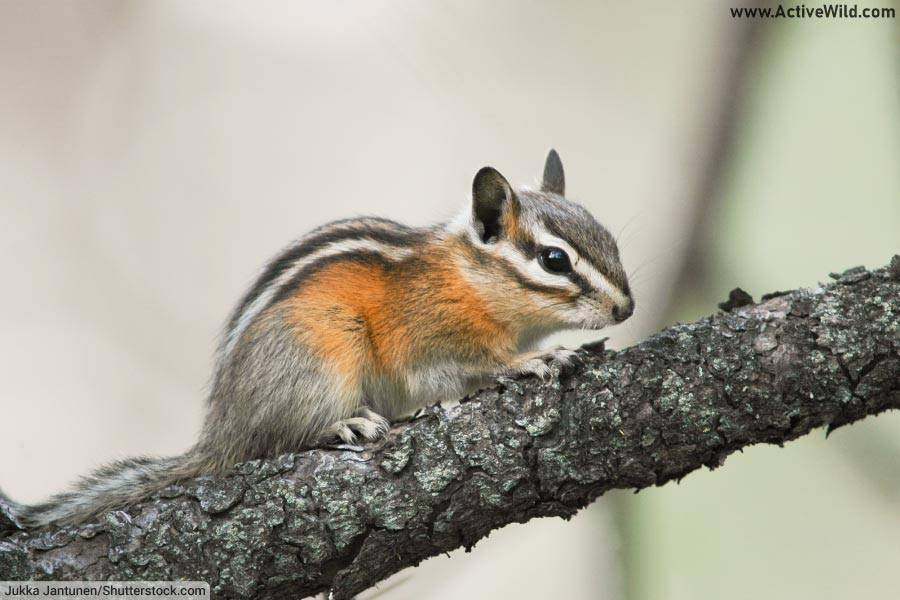
- Scientific name: Neotamias amoenus
- Type of animal: Mammal
- Family: Sciuridae
- Where found: North America
- Conservation status: Least Concern
The yellow-pine chipmunk, like all chipmunks, is a rodent in the squirrel family Sciuridae. This family is home to all squirrels, including tree squirrels, ground squirrels, marmots and prairie dogs.
The yellow-pine chipmunk has reddish-gray fur marked with five black and two white stripes. Its face is also striped. The species is found in the western United States and Canada.
Discover More with Active Wild
You can find out more about rodents on this page: Rodents – The Ultimate Guide
You can find out more about mammals on this page: Mammals – The Ultimate Guide
You can see more North American animals on this page: North American Animals Pictures & Facts
Yellow-Throated Marten
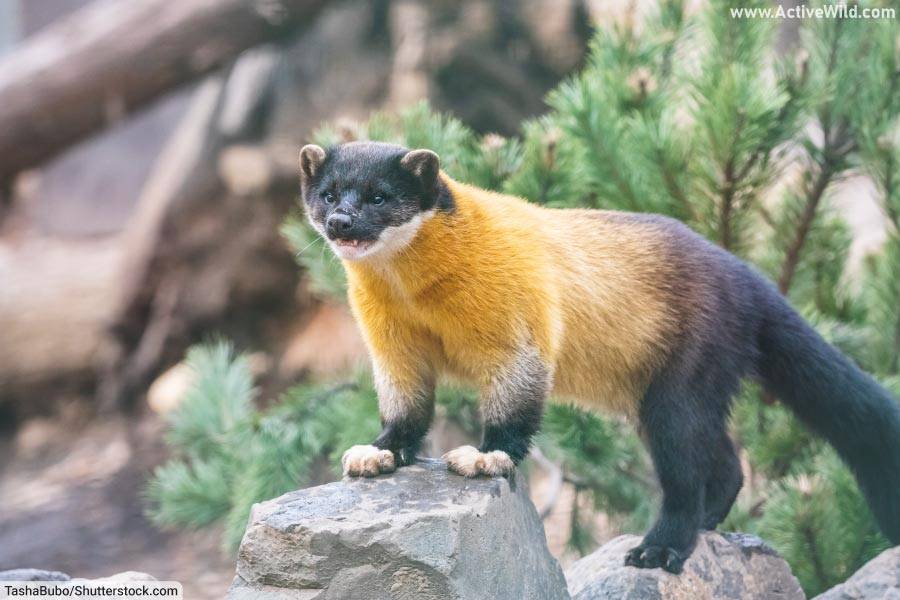
- Scientific name: Martes flavigula
- Type of animal: Mammal
- Family: Mustelidae
- Where found: Asia
- Conservation status: Least Concern
The yellow-throated marten is a mid-sized predatory mammal found in Asia. It is the largest member of the weasel family Mustelidae found in the Old World (the continents of Europe, Asia and Africa).
The yellow-throated marten’s tail and hindquarters are dark brown. Its back, neck and shoulders are yellow, hence the species’ name.
Like other members of the weasel family (which is home to the honey badger and the wolverine), the yellow-throated marten is tough beyond its size, and has few natural predators.
Discover More with Active Wild
You can see more Asian animals on this page: Asian Animals List with Pictures & Facts
You can find out more about mammals on this page: Mammals – The Ultimate Guide
Yellow-Winged Bat
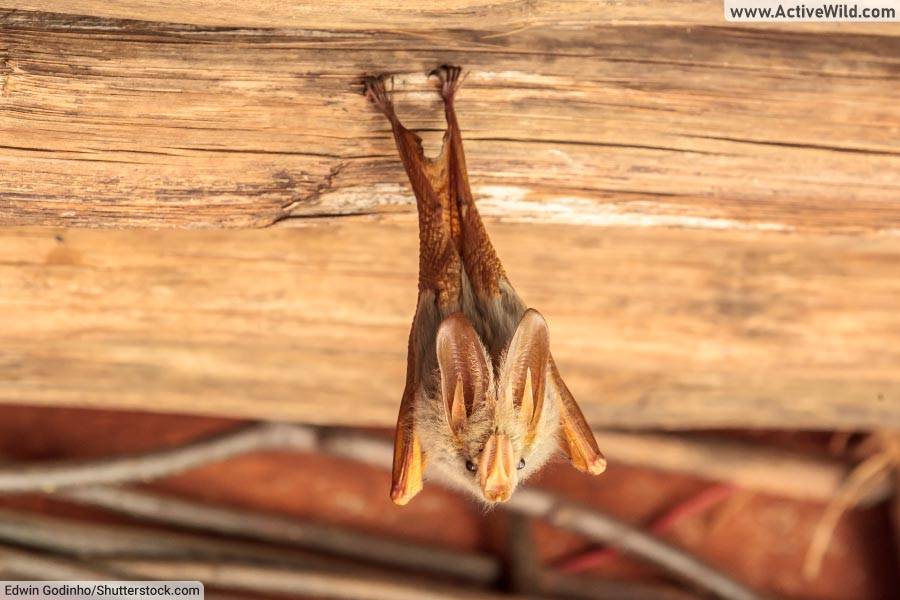
- Scientific name: Lavia frons
- Type of animal: Mammal
- Family: Megadermatidae
- Where found: Africa
- Conservation status: Least Concern
Like all bats, the yellow-winged bat is a flying mammal, unrelated to birds. Bats make up the order Chiroptera, which is the second-largest order of mammals; around 20% of all mammals are bats. (The largest mammal order is Rodentia; there are over 2,000 rodent species.)
The yellow-winged bat is member of the “false vampire bat” family, Megadermatidae. Species in this group were once thought to drink blood, like the “true” vampire bats of Central and South America.
This assumption was later found to be false, although three members of the family are notable for being among the few bats that prey on other bats.
The yellow-winged bat is found in Africa, in a broad band stretching from east to west below the Sahara Desert. It is absent from southern Africa. The species has distinctive yellow-colored wings, ears and nose.
Found near rivers in savannas, scrublands and woodlands, the yellow-winged bat preys on a variety of insects.
Discover More with Active Wild
Discover more about bats on this page: Bats – The Ultimate Guide
You can see more African animals on this page: African Animals List with Pictures & Facts
Yorkshire Terrier

- Scientific name: Canis lupus familiaris / Canis familiaris
- Type of animal: Mammal
- Family: Canidae
- Conservation status: Domestic
The Yorkshire terrier, also known as a “Yorkie”, is a small domestic dog breed. It originated in Yorkshire, a county in northern England, in the mid-19th Century. It was bred to be a ratter, but has since become a popular pet in many parts of the world.
Yorkshire terriers have long hair and are usually black and tan in color. These affectionate little dogs are territorial and likely to bark at perceived “threats”.
Discover More with Active Wild
You can find out more about dogs on this page: Dog Facts
You can see EVERY species of dog on this page: Dog Species with Pictures & Facts
Yucatan Squirrel
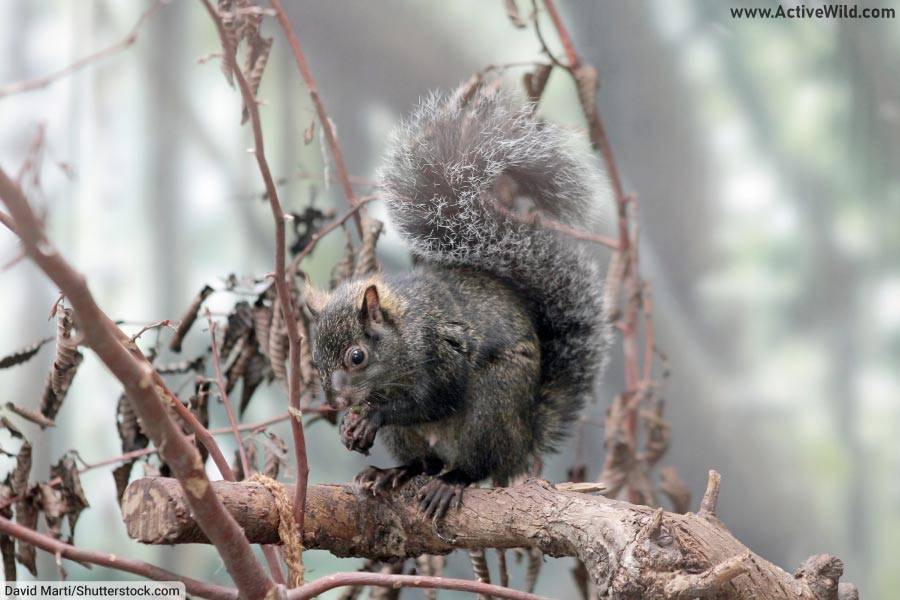
- Scientific name: Sciurus yucatanensis
- Type of animal: Mammal
- Family: Sciuridae
- Where found: North America
- Conservation status: Least Concern
The Yucatan squirrel is a rodent in the squirrel family, Sciuridae. It is found in forests in the Yucatán Peninsula, a peninsula of southeastern Mexico and parts of Belize and Guatemala.
Like all tree squirrels, the Yucatan squirrel is mainly arboreal (tree-dwelling), spending most of its life in trees, where it forages for nuts and seeds.
The Yucatan squirrel is fairly common in its range and able to tolerate a degree of change to its habitat.
Discover More with Active Wild
You can find out more about rodents on this page: Rodents – The Ultimate Guide
You can find out more about mammals on this page: Mammals – The Ultimate Guide
You can see more North American animals on this page: North American Animals Pictures & Facts
Yuma Myotis
(No image available)
- Scientific name: Myotis yumanensis
- Type of animal: Mammal
- Family: Vespertilionidae
- Where found: North America
- Conservation status: Least Concern
The Yuma myotis is a small, insectivorous (insect-eating) bat found in western North America, from southern Canada to central Mexico. It belongs to the family Vespertilionidae, a group of bats known as “vesper bats”. With almost 500 species, Vespertilionidae is by far the largest bat family.
The Yuma myotis lives in colonies that can contain up to 10,000 individuals. It inhabits a variety of habitats, and is usually found close to water.
Although currently listed as “Least Concern”, the Yuma myotis is susceptible to White-nose syndrome – a disease that, since 2012, has been responsible for the deaths of 5 to 7 million bats.
Discover More with Active Wild
You can find out more about bats on this page: Bats – The Ultimate Guide
You can see more North American animals on this page: North American Animals Pictures & Facts
Discover more about the different types of mammal on this page: Types Of Mammals
Animals That Start With Y: Conclusion
We hope that you’ve discovered some interesting animals with names beginning with Y on this page.
You can discover more animals in our A to Z animals section by clicking on the letters below…
The post Animals That Start With Y: List With Pictures & Interesting Facts appeared first on Active Wild.


























